Low-Cost Carrier (LCC) Market Size and Share
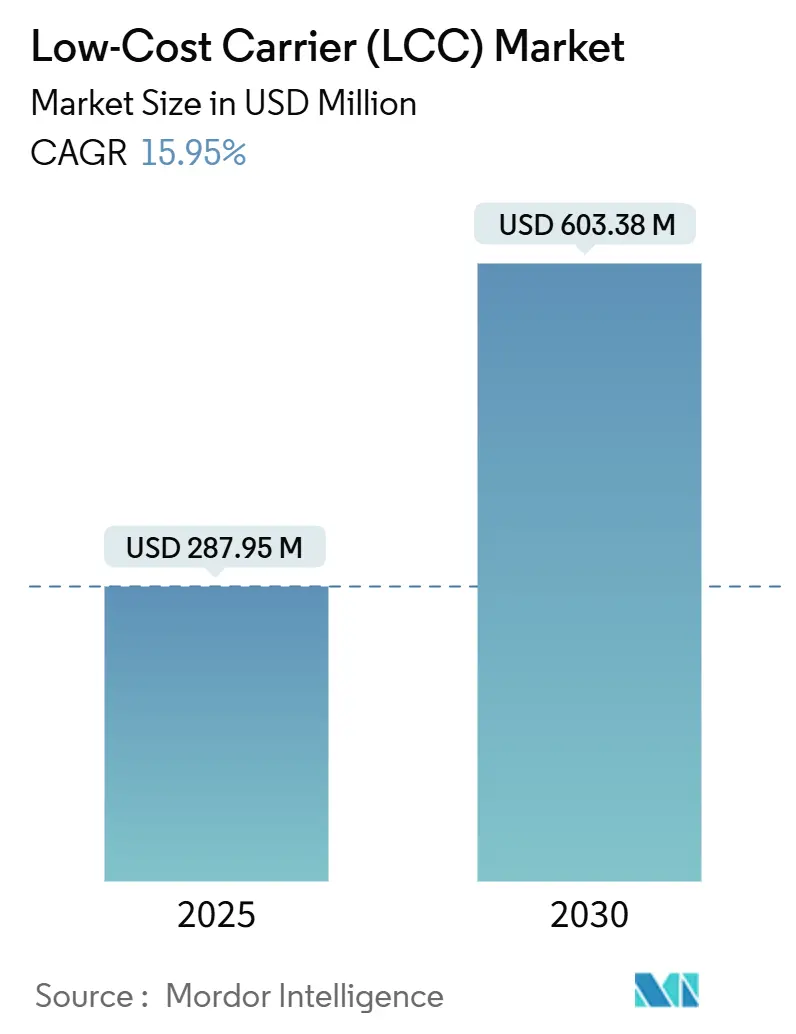
Low-Cost Carrier (LCC) Market Analysis by Mordor Intelligence
The low-cost carrier (LCC) market stands at USD 287.95 million in 2025 and is forecasted to reach a market size of USD 603.38 million by 2030, advancing at a 15.95% CAGR. This growth reflects a demand rebound that has pushed global passenger volumes to 105% of 2019 levels, led by leisure and VFR travellers who consistently prioritise price over frills. Fleet renewal centred on A320neo and B737 MAX aircraft is delivering 15–20% reductions in cost per available seat-mile, reinforcing the structural cost advantage that defines the LCC market. Growing acceptance of extended-range A321XLR jets expands addressable networks into thin long-haul city-pairs, while liberalised air-service agreements unlock cross-border expansion opportunities. Digital sales channels capture the entire booking flow, allowing carriers to refine dynamic pricing and ancillary bundles that lift yield without eroding the fare advantage. These factors create a virtuous cycle of rising utilisation, lower unit cost, and robust cash generation.
Key Report Takeaways
- By aircraft type, narrowbody jets led with 80.85% revenue share in 2024, whereas widebody operations are projected to grow at a 17.89% CAGR through 2030.
- By destination, domestic services accounted for 60.35% of the LCC market size in 2024; international routes are forecast to expand at a 17.30% CAGR to 2030.
- By haul length, short-haul flights captured 71.89% of the LCC market share in 2024, while long-haul routes are advancing at an 18.10% CAGR over the same horizon.
- By distribution channel, direct online sales held a 94.75% share in 2024 and continue growing at 16.01% CAGR.
- By geography, Asia-Pacific held 32.18% of overall revenues in 2024; the Middle East and Africa is the fastest-growing region at 17.14% CAGR.
- • IndiGo, Ryanair, and flydubai together controlled more than 20% of global traffic in 2024, with IndiGo alone holding 64.4% domestic share in India
Global Low-Cost Carrier (LCC) Market Trends and Insights
Drivers Impact Analysis
| Driver | (~) % Impact on CAGR Forecast | Geographic Relevance | Impact Timeline |
|---|---|---|---|
| Surge in price-sensitive leisure and VFR traffic | +3.2% | Global, strongest in Asia-Pacific and Europe | Medium term (2-4 years) |
| Global fleet modernization driven by next-generation narrowbody aircraft | +2.8% | Global, led by North America and Europe | Long term (≥4 years) |
| Liberalisation of bilateral air-service agreements | +1.9% | Global, particularly Africa and South America | Long term (≥4 years) |
| Ancillary-revenue digitalisation boosting yield | +2.1% | Global, advanced in North America and Europe | Medium term (2-4 years) |
| Lower carbon intensity per seat of high-density single-aisle fleets aligning with ICAO CORSIA targets | +1.4% | Global, with regulatory pressure concentrated in Europe | Medium term (2-4 years) |
| Global availability of under-utilised secondary and tertiary airports offering major fee discounts | +1.6% | Global, with highest impact in developing markets | Short term (≤ 2 years) |
| Source: Mordor Intelligence | |||
Surge in Price-Sensitive Leisure and VFR Traffic Restoring Passenger Volumes
Leisure and VFR segments have returned faster than corporate travel, filling aircraft across major regions. European carriers illustrate the shift, with LCC passengers comfortably outnumbering those on legacy airlines. The positive load-factor trend is mirrored in Asia-Pacific, where regional travel bubbles and relaxed visa policies encourage short-notice bookings. Higher load factors allow incremental fare increases that protect margins without sacrificing competitiveness. Importantly, the recovery in outbound tourism from emerging middle-class economies keeps growth broad-based rather than confined to a few large domestic markets. As travel aspirations normalise, the LCC market capitalizes on price elasticity, favoring frequency and directness of service over cabin frills.
Global fleet modernization driven by next-generation narrow-body aircraft
The newest single-aisle models burn less fuel, carry more seats, and require fewer maintenance hours. Ryanair’s B737-8200 programme and Indigo’s 500-unit Airbus order underline the scale advantages locked in for the next decade. Airlines deploying the A321XLR gain an additional 700–800 nm range compared with current LR variants, letting them add high-yield secondary city pairs without a wide-body cost base. These gains translate directly into marginal-cost advantages, ensuring the LCC market defends its pricing edge even as fuel or labour costs fluctuate. New-generation engines also support improved carbon intensity, aligning with the tightening ICAO CORSIA trajectory.
Liberalisation of Bilateral Air-Service Agreements and Proliferation of Open-Skies Accords
Open-skies policies remove capacity, frequency, and ownership caps that historically protected flag carriers. The US now has more than 130 such treaties, a framework that lowers fares by 32% on exposed routes. Newly liberalised corridors in Africa and South America allow nimble LCCs to enter first and establish brand loyalty before infrastructure catches up. Partnerships structured under these liberal frameworks let carriers pool sales platforms and loyalty programmes without full equity integration, reducing risk while extending network reach. The trend dovetails with secondary-airport strategies, where capacity constraints are minimal and incentive packages are attractive. As more governments embrace liberalisation to stimulate tourism recovery, the LCC market opens new city-pairs at a pace that legacy networks cannot easily match.
Ancillary Revenue Digitalisation Boosting Yield
Selling extras such as seat selection, meals, and priority boarding has moved from static menus to AI-driven dynamic offers pushed through mobile apps. Ryanair generated EUR 4.72 billion (USD 5.42 billion) in ancillary sales during 2024-25, roughly 35 % of its total revenue. Personalised bundling engines raise take-rate and average spend without diluting base-fare discipline. Direct channels let carriers A/B-test pricing in real time, feeding machine-learning models that sharpen customer segmentation and conversion. As payment-platform costs fall, even micro-transactions become profitable. Digitalised ancillaries therefore provide a cushion against fuel-price swings and residual demand uncertainty, reinforcing the cash-flow resilience of the LCC market.
Restraints Impact Analysis
| Restraint | (~) % Impact on CAGR Forecast | Geographic Relevance | Impact Timeline |
|---|---|---|---|
| Persistent airframe, engine and avionics supply-chain bottlenecks | -2.4% | Global | Medium term (2-4 years) |
| Escalating environmental taxes and carbon-pricing schemes on short-haul flights | -1.8% | Europe and North America | Long term (≥ 4 years) |
| Jet-fuel crack-spread volatility and limited fuel-hedging capability outside Europe | -1.6% | Global, with highest impact in emerging markets | Short term (≤ 2 years) |
| Worldwide pilot, engineer and cabin-crew shortages inflating labour costs | -2.1% | Global, with acute shortages in Asia-Pacific and North America | Medium term (2-4 years) |
| Source: Mordor Intelligence | |||
Persistent Airframe, Engine and Avionics Supply-Chain Bottlenecks Driving Delivery Delays
Shortages of castings, forgings, and engine cores have pushed aircraft hand-overs more than 24 months past schedule. Airbus trimmed its 2025 output target and confirmed that the A320 family ramp-up is now delayed to 2027. Carriers are extending leases on older jets, sacrificing fuel-burn gains and increasing maintenance costs. Deferred capacity cascades into constrained seat supply, tempering the LCC market's ability to exploit recovering demand fully. Additional working capital is tied up in pre-delivery payments, and training pipelines for pilots and technicians must be rescheduled, adding complexity to manpower planning. Although OEMs forecast clearer output visibility from late-2025, progress remains uneven across sub-tiers, sustaining the headwind.
Escalating Global Environmental Taxes and Carbon-Pricing Schemes on Short-Haul Flights
The European Union’s ReFuelEU Aviation rule mandates a 2% sustainable aviation-fuel blend from 2025, rising incrementally to 70% by 2050. Lufthansa has already introduced surcharges of up to EUR 72 (USD 83) per flight to fund compliance, highlighting the pass-through pressure even on high-yield segments. Every extra cent matters for the fare-sensitive LCC market; yet single-aisle density provides some insulation because per-seat emissions are lower. As more jurisdictions replicate carbon levies, the risk of modal shift to rail on sub-800 km routes grows, especially in Europe. Carriers must calibrate network plans carefully and lobby for technology-neutral incentives that recognise the emissions efficiency they already deliver.
Segment Analysis
By Aircraft Type: Single-Aisle Strength with Wide-Body Upside
Narrowbody fleets account for 80.85% of 2024 revenues, underlining the cost-per-seat supremacy that anchors LCC economics. The segment’s scale continues to rise as carriers lock in forward orders; Ryanair alone has options that could lift its fleet above 800 aircraft by 2033. Despite this dominance, wide-body utilisation is the fastest mover, growing at 17.89% CAGR. Much of that growth is effectively generated by the A321XLR, a single-aisle aircraft serving long-thin missions traditionally counted as wide-body territory. This blurring benefits the LCC market by allowing a wide-body-like range without the associated trip cost.
As residual feedstock of second-hand A330s and B787-8s becomes cheaper, opportunistic long-haul start-ups may also contribute incremental capacity. However, spare-engine shortages could temper inductions until 2026. The LCC market size for wide-body operations is expected to double by 2030, even under conservative delivery scenarios, though profitability will hinge on maintaining 80 %+ load factors during seasonally weak months. Flexible leasing structures and power-by-the-hour engine agreements mitigate some risk, compelling the strategic case for selective wide-body growth.
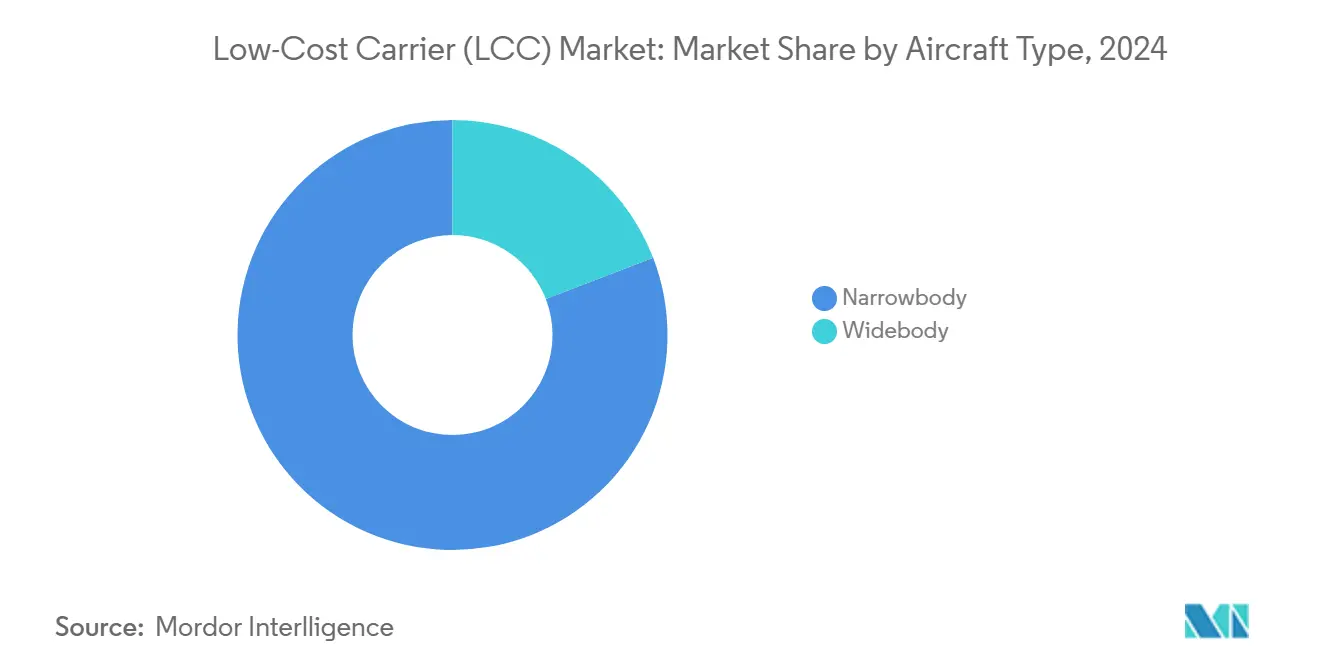
Note: Segment shares of all individual segments available upon report purchase
By Destination: International Network Momentum Builds
Domestic flying still represents 60.35% of 2024 revenue as point-to-point connectivity inside large landmasses remains the bedrock of the LCC market. Yet international segments are advancing at a 17.30% CAGR, fuelled by the relaxation of visa regimes and reciprocal open-skies deals. IndiGo’s decision to double its international stations to 40 by March 2025 showcases the pivot towards cross-border opportunities. Seasonal peaks on leisure-oriented city pairs are also flattened through continuous scheduling, boosting aircraft utilisation.
As cross-border slots at constrained primary airports grow scarce, secondary airports offer a release valve, often bundled with fee holidays and marketing support. If slot allocation processes remain liberal, the LCC market size attached to international routes could eclipse USD 300 million by 2030. The main execution risk is currency volatility, which can erode yields once denominated in the home currency. Hedging programmes and revenue diversification by ancillary partnerships are expanding to protect margin integrity.
By Haul Length: Long-Haul Economics Turning Positive
Short-haul flights account for 71.89% of current activity, reflecting the historic sweet-spot of 90-minute sectors that optimise crew and aircraft productivity. Long-haul, however, is the star performer with an 18.10% CAGR. The improvement is traced to higher-density cabin layouts and reduced turn-time goals even on trans-Atlantic services. Air Canada plans to use its 30-strong A321XLR fleet on routes such as Halifax–Dublin, avoiding the wide-body cost premium while offering nonstop convenience.
Network data shows that 2,500–4,500 nm thin routes are no longer an automatic monopoly for legacy carriers. The LCC market share on these lanes is still modest but climbing quickly as marketing alliances create virtual long-haul networks. To protect reliability, carriers invest in spare pools at outstations, lessening the risk of AOG events far from base. If fuel prices remain within the USD 75–90 per-barrel band, break-even load factors below 80% are achievable, sustaining the long-haul experiment beyond a niche proposition.
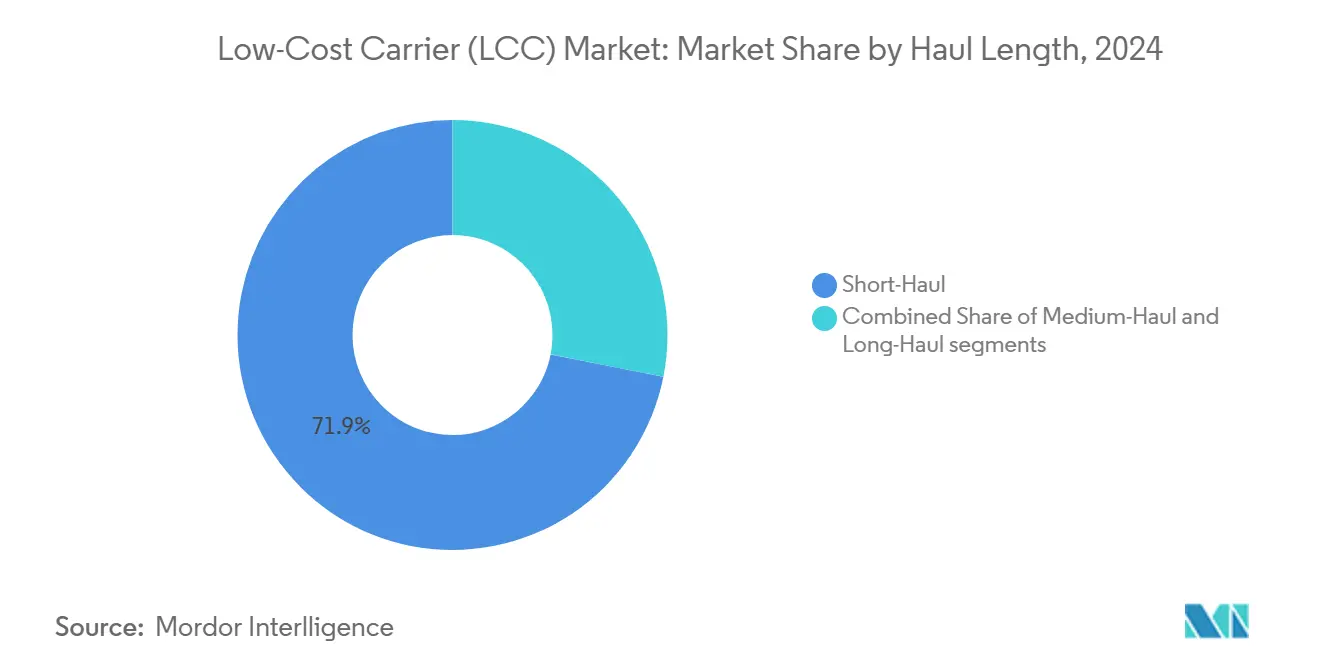
Note: Segment shares of all individual segments available upon report purchase
By Distribution Channel: Digital Direct Dominance
At 94.75%, direct online channels capture almost all of ticket sales, which underlines how critical ownership of the customer relationship has become. Dynamic-offer systems price the seat and every ancillary, trained on behavioural data gathered over millions of searches. Wizz Air’s capped “all-you-can-fly” annual pass illustrates the willingness to push new subscription models that build liquidity upfront while locking in future demand.
Global adoption of IATA’s NDC standard empowers airlines to retail richer content, including carbon offset bundles and airport transfer vouchers, in a single transaction. As mobile wallet penetration climbs, payment conversion improves, and fraud rates fall. The LCC market benefits disproportionately because lean IT stacks allow fast iteration compared with legacy airlines bound by legacy PSS architecture. Looking ahead, conversational commerce through chatbots and in-app live agents will further compress sales friction and lift basket size.[1]Wizz Air, “All You Can Fly Pass Announcement,” wizzair.com
Geography Analysis
Asia-Pacific anchors the LCC market with a 32.18% share and reinforces that position through aggressive fleet additions. IndiGo carried 100 million passengers in 2025, reflecting domestic demand buoyed by rising disposable income and a young demographic profile.[2]IndiGo, “100 Million Passengers Milestone,” goindigo.in Every percentage-point uptick in Indian GDP per capita historically triggers an even stronger lift in air-travel propensity, signalling that secular tailwinds are intact. The airport-privatisation wave across Indonesia, the Philippines, and Vietnam is upgrading secondary airfields, creating fertile ground for new entrants.
Middle East and Africa, while smaller in absolute terms, is the fastest mover at 17.14% CAGR. Flydubai leverages Dubai’s sixth-freedom hub positioning to bridge underserved city pairs spanning Europe, Africa, and South-East Asia.[3]flydubai, “2025 Network and Financial Performance,” flydubai.com Growth is further encouraged by liberal BASAs and an expanding low-cost terminal footprint in Riyadh and Jeddah. African governments, eager to stimulate tourism and compete with Gulf hubs, are streamlining visa-on-arrival processes, which supports the outward push of carriers such as flynas.
Europe remains an established laboratory for the LCC model, yet faces tightening environmental constraints. The French domestic ban on flights that could be replaced by rail on sub-2.5-hour journeys is an early example of regulatory friction. Even so, load factors remain high because holidaymakers from Germany, the United Kingdom and Scandinavia gravitate to Mediterranean destinations not easily accessible by high-speed rail. Currency-denominated fuel exposure in South America introduces volatility, but the new Argentine administration’s push to deregulate fares could unlock sizeable upside for local players if policy momentum holds.
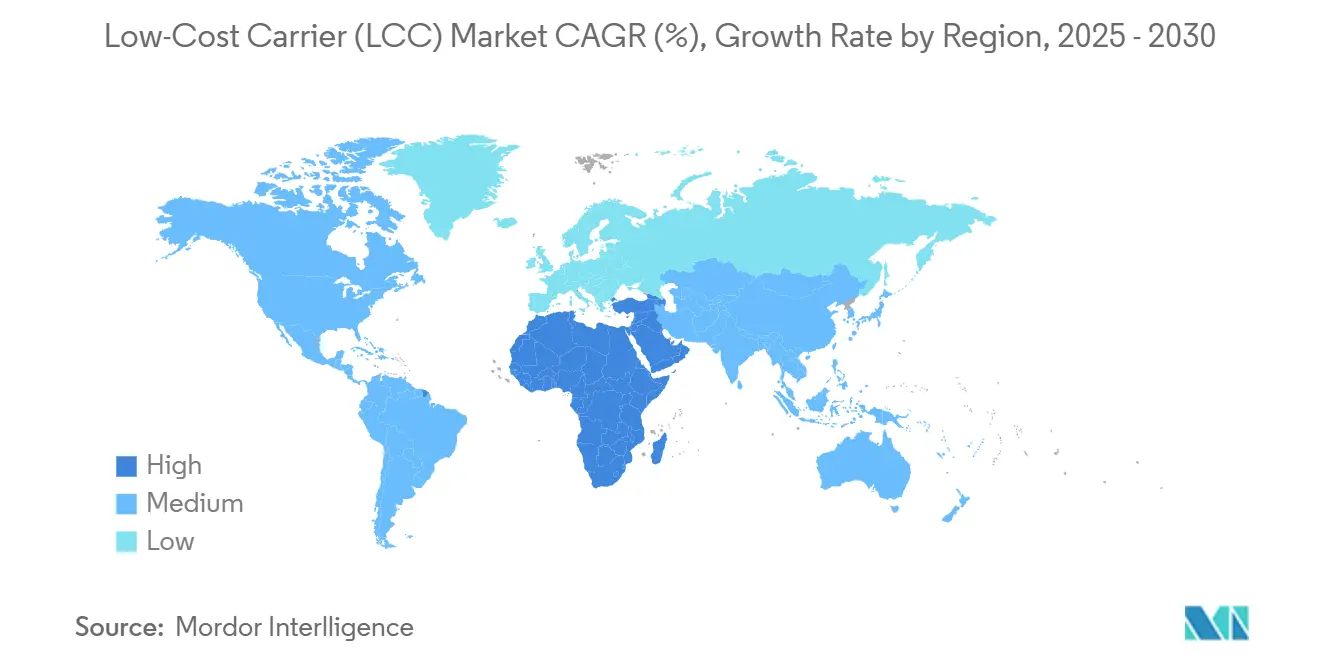
Competitive Landscape
Competitive intensity rises as supply constraints curb capacity growth, allowing incumbents to monetise pricing power while keeping fares below legacy averages. Ryanair, EasyJet, and Wizz Air collectively deploy more than 600 aircraft and maintain cash reserves that dwarf most new entrants, giving them a scale moat in slot-constrained airports. At the same time, the LCC industry is experimenting with hybrid upgrades: Southwest is piloting assigned seating, and Spirit plans bundled fare families that inch closer to legacy service levels without surrendering cost discipline.
Digital capability is the next frontier. easyJet has rolled out artificial-intelligence decision support across 2,000 daily flights, cutting delay minutes and lowering preventable maintenance events. Ryanair’s app has 50 million active users, acting as a launch pad for cross-selling hotels, car hire, and event tickets that add high-margin revenue. IndiGo’s scale in Asia-Pacific provides procurement leverage: sizeable block purchases of ACF-flex seats, wheels-and-brakes pools, and even SAF volumes allow it to negotiate rates smaller airlines cannot access.
Consolidation plays are likely to accelerate. Korean Air’s plan to combine Jin Air with Asiana’s Air Busan and Air Seoul units will create a group controlling nearly one-fifth of Korean domestic traffic, reshaping competition on regional routes. Norwegians’ disciplined return after restructuring, plus the potential for Ita Airways to down-gauge certain Mediterranean services, will open fresh code-share and wet-lease opportunities in Europe. Given persistent input-cost volatility and FX swings, balance sheets with low net leverage remain a strategic asset that lets carriers ride out shocks without diluting shareholders.
Low-Cost Carrier (LCC) Industry Leaders
-
Southwest Airlines Co.
-
Ryanair
-
easyJet PLC
-
Indigo (InterGlobe Aviation Limited)
-
Wizz Air Group
- *Disclaimer: Major Players sorted in no particular order
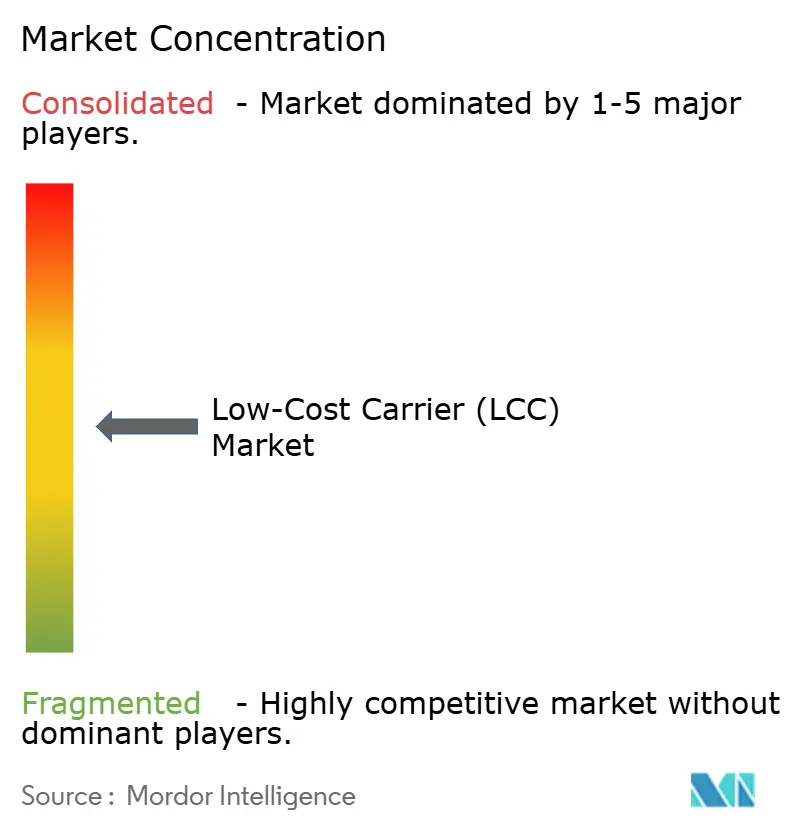
Recent Industry Developments
- May 2025: IndiGo signed an agreement with Norse Atlantic Airways, a Norwegian low-cost carrier, for the damp leasing of two B787 Dreamliner aircraft, expanding its wide-body fleet.
- May 2024: Travelport, a global travel technology company that processes bookings for travel suppliers worldwide, renewed its LCC content agreement with flynas, a major low-cost airline in the Middle East.
Research Methodology Framework and Report Scope
Market Definitions and Key Coverage
In our study, Mordor Intelligence defines the low-cost carrier (LCC) market as the worldwide ticket and ancillary revenue earned by scheduled airlines that operate single-class, point-to-point services, use a lean cost structure, and charge separately for optional conveniences. We track only commercial passenger flights operated by jet aircraft and converted passenger freighters.
Scope Exclusion: charter-only flights, cargo-only operators, and turboprop commuter services lie outside this analysis.
Segmentation Overview
- By Aircraft Type
- Narrowbody
- Widebody
- By Destination
- Domestic
- International
- By Haul Length
- Short-Haul
- Medium-Haul
- Long-Haul
- By Distribution Channel
- Online Direct
- Travel Agency
- Geography
- North America
- United States
- Canada
- Europe
- Germany
- United Kingdom
- France
- Italy
- Spain
- Rest of Europe
- Asia-Pacific
- China
- India
- Japan
- South Korea
- Rest of Asia-Pacific
- South America
- Brazil
- Rest of South America
- Middle East and Africa
- Middle East
- Saudi Arabia
- United Arab Emirates
- Rest of Middle East
- Africa
- South Africa
- Rest of Africa
- Middle East
- North America
Detailed Research Methodology and Data Validation
Primary Research
Mordor analysts interview airline revenue-management executives, aircraft lessors, and online travel agency leaders across North America, Europe, Asia-Pacific, and the Middle East. These conversations validate ancillary penetration, average stage length, and expected capacity additions, helping us refine assumptions that could never be confirmed by desk work alone.
Desk Research
Our team begins with global aviation traffic statistics from sources such as the International Civil Aviation Organization, IATA's World Air Transport Report, and regional regulators that release passenger-kilometer data. We then gather fleet delivery, utilization, and fuel price trends from Airbus, Boeing, and Eurocontrol dashboards, which are invaluable for cost benchmarks.
Company filings, airline investor presentations, airport authority throughput sheets, and trade association briefs (Airlines for America, ACI World, CAPA insights) help us narrow typical fares, ancillary share, and load factors by region. Subscription databases like D&B Hoovers and Dow Jones Factiva are tapped for historical revenue splits and news on surcharge policies. This list is illustrative; many additional sources support data collection and cross-checks.
Market-Sizing & Forecasting
The model starts with a top-down build: global scheduled passenger revenue is reconstructed, then filtered through LCC seat-capacity share, region-specific load factors, and ancillary-to-ticket ratios. Select bottom-up checks, sampled airline revenues and aircraft counts multiplied by stage length and average seat-kilometer yields, calibrate totals.
Key variables include jet fuel spot prices, delivered A320neo/B737 MAX counts, digital booking penetration, and government tourism indices, each influencing cost per available seat-mile and fare elasticity. A multivariate regression with these drivers projects revenue through 2030, while scenario analysis handles swings in fuel and taxation. Where bottom-up samples fall short, we adjust using median variance from audited carriers in similar markets.
Data Validation & Update Cycle
Draft outputs go through variance checks against independent passenger data, analyst peer reviews, and anomaly resolution before sign-off.
Reports refresh yearly, and any material event, such as fleet groundings, open-skies pacts, or sudden tax hikes, triggers an interim update so clients receive the freshest view.
Why Mordor's Low-Cost Carrier Baseline Proves Dependable
Published market values often diverge because each firm selects distinct service scopes, fare definitions, and refresh cadences.
Key gap drivers include whether charter and cargo revenue is folded into totals, how ancillary sales are treated, the vintage of fleet data, and currency conversion dates. Mordor favors current-year airline filings, excludes non-passenger revenue, and refreshes annually, whereas many publishers rely on broader IATA aggregates or older averages, creating wider figures.
Benchmark comparison
| Market Size | Anonymized source | Primary gap driver |
|---|---|---|
| USD 287.95 million (2025) | Mordor Intelligence | |
| USD 320.61 billion (2025) | Global Consultancy A | Includes charter and cargo revenue, gross fare without ancillary split |
| USD 316.97 billion (2024) | Trade Journal B | Uses passenger volume × average fare and 2023 fleet data |
The comparison shows that numbers swing widely when scope or inputs drift. By anchoring estimates to audited airline revenue streams, timely capacity data, and clearly documented exclusions, Mordor Intelligence delivers a balanced, transparent baseline that decision-makers can trace back to reproducible steps.
Key Questions Answered in the Report
How large is the LCC market in 2025?
The LCC market is valued at USD 287.95 million in 2025 and is projected to expand to USD 603.38 million by 2030 at a 15.95% CAGR.
Which region leads the LCC market today?
Asia-Pacific holds the largest revenue share at 32.18%, supported by passenger-growth milestones such as IndiGo carrying 100 million customers in a year.
What drives long-haul growth for low-cost carriers?
Extended-range single-aisle aircraft like the A321XLR enable profitable operation on thin trans-continental routes, delivering range without wide-body trip-cost penalties.
How important is ancillary revenue to LCC profitability?
Ancillary sales contributed EUR 4.72 billion (USD 5.42 billion) for Ryanair in 2024-25, demonstrating that personalised add-ons can represent more than one-third of total revenue for leading carriers.
What are the biggest restraints facing the sector?
Supply-chain delays on new aircraft and tightening environmental levies on short-haul flights currently subtract an estimated 4.2 percentage points from otherwise higher growth momentum.
Which sales channel dominates LCC bookings?
Direct online platforms capture 94.75% of tickets, allowing carriers to exploit dynamic pricing and personalized bundles while reducing distribution costs.
Page last updated on:



